Greece, Classical Art (480-323 B.C.)
This period of Greek art begins with the Persian Wars, the time of the defeat of Persian King Xerxe's attempted invasion of Greece, and ends with the death of Alexander the Great of Macedon. This was the period of Athenian preeminence among the Greek
states. The Athenians were the only Greeks to stand up to Xerxes, and their success against the Persians raised their pride and their status among their peers. The works of this period are considered a benchmark
in the history of Western art. This is the period during which the Greek ideal of beauty was formed and their most cherished works achieved.
Classical pottery
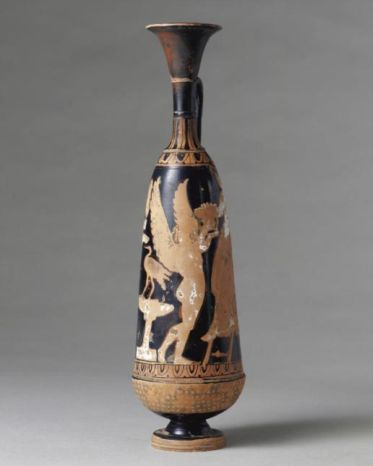
Attic red-figure, early fourth century B.C.; 25.7 cm., Sotheby's New York. Lekythoi were used in funeral ceremonies and held olive oil. The deceased was often depicted on the pot. On this lekythos, we see a woman holding a mirror, with Eros handing something to another woman on a ladder.

Attic red figure amphora attributed to the Suessula painter, ca. 410 - 400 B.C.; clay, with white and black painting, depicting a battle of the Gods and Giants. In the very center is Zeus who is about to strike a Giant with a thunderbolt. Herakles stands below Zeus and is ready with his sword. Underneath Herakles, Athena carries a spear with which to kill the Giant. The function of the amphora was to keep wine cool. The vases of this period show more use of gilding and a wider range of colors.

Greek lamp, ca. 380 B.C., clay with black slip; 8.5 x 5.6 x 3.6 cm. The simple, appealing Greek lamps of this period were mostly terracotta, with a spout used for the wick, the center for the oil and often a handle. They were thrown on a pottery wheel. Unlike other pottery, which were not decorated, these lamps were glazed with black paint in some areas.
Classical sculpture
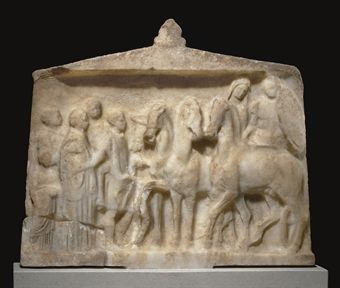
Greek marble votive (religious) relief, ca. 4th century B.C., worshippers huddle on the left as a mounted warrior with spear approaches. Christies, New York, sale of 9 December 2008.

Warrior, bronze with gold, silver, glass, copper. 4th century B.C., Greek, 200 cm., Museo Nazionale, Reggio Calabria. The arms, legs, and locks of hair were separately attached. This statue is a hollow, lost-wax cast.

Theatre chair, ca. 350 B.C., marble, inscribed by its maker: Boethius on the side of the seat. J. Paul Getty Museum, Malibu, CA.

Red figured vase, perhaps the Cleophon painter, ca. 420 - 400 B.C.; 8.6 x 4.3 cm.; A chimarera on one side; Bellerophon on Pegasus on the other side; Louvre, Paris, France.
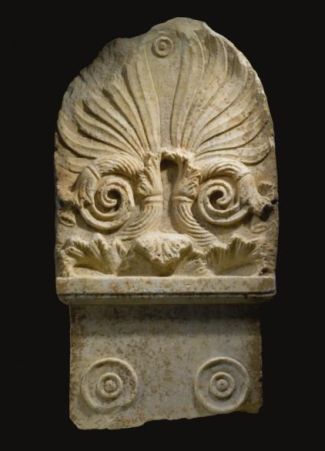
Greek marble Anthemion (funerary stele), ca. 325 B.C., rosetts in relief, two acanthus stalks, palmettes; 109.2 x 57.8 cm.

Fragment of marble statue of woman's head, Greek, ca. 350 B.C.; believed to be from a funeral stele.

Doe statue, ceramic, ca. 450 B.C., Athenian, 13.7 cm.,
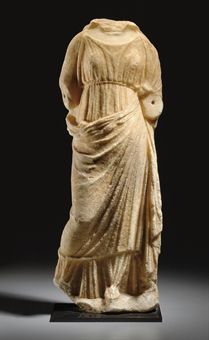
Statue of a woman, marble, ca. 340 B.C.; Athenian, wearing traditional belted chiton, long hair visible on shoulders, 43.1 cm. high.
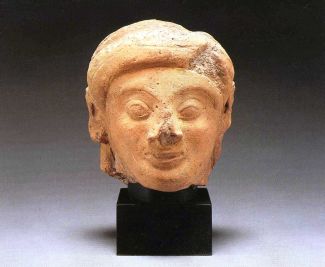
Kylix, Drinking cup, Greek, ca. 350 B.C. 22 cm. wide.
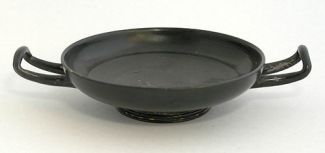
Kylix, Drinking cup, Greek, ca. 350 B.C. 22 cm. wide.
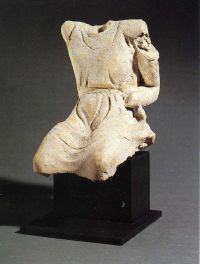
Female torso, fragment, terracotta, Greek ca. 4th century B.C.; woman wearing belted chiton; 19.5 cm.
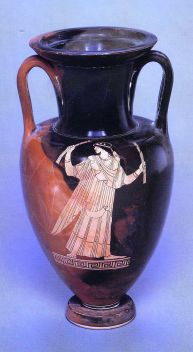
Red-figure amphora, Attic (Athenian); After the Berlin
painter, ca. 470 B.C.; 35.9 cm.; young woman carrying torches, wearing
highly detailed chiton.
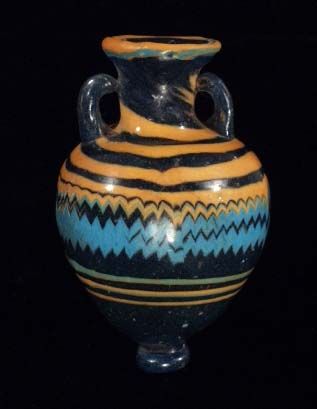
Amphoriskos, Greek, blue, yellow and other colors, ca. 450
B.C.; 7 cm., Hermitage Museum, Russia.
|